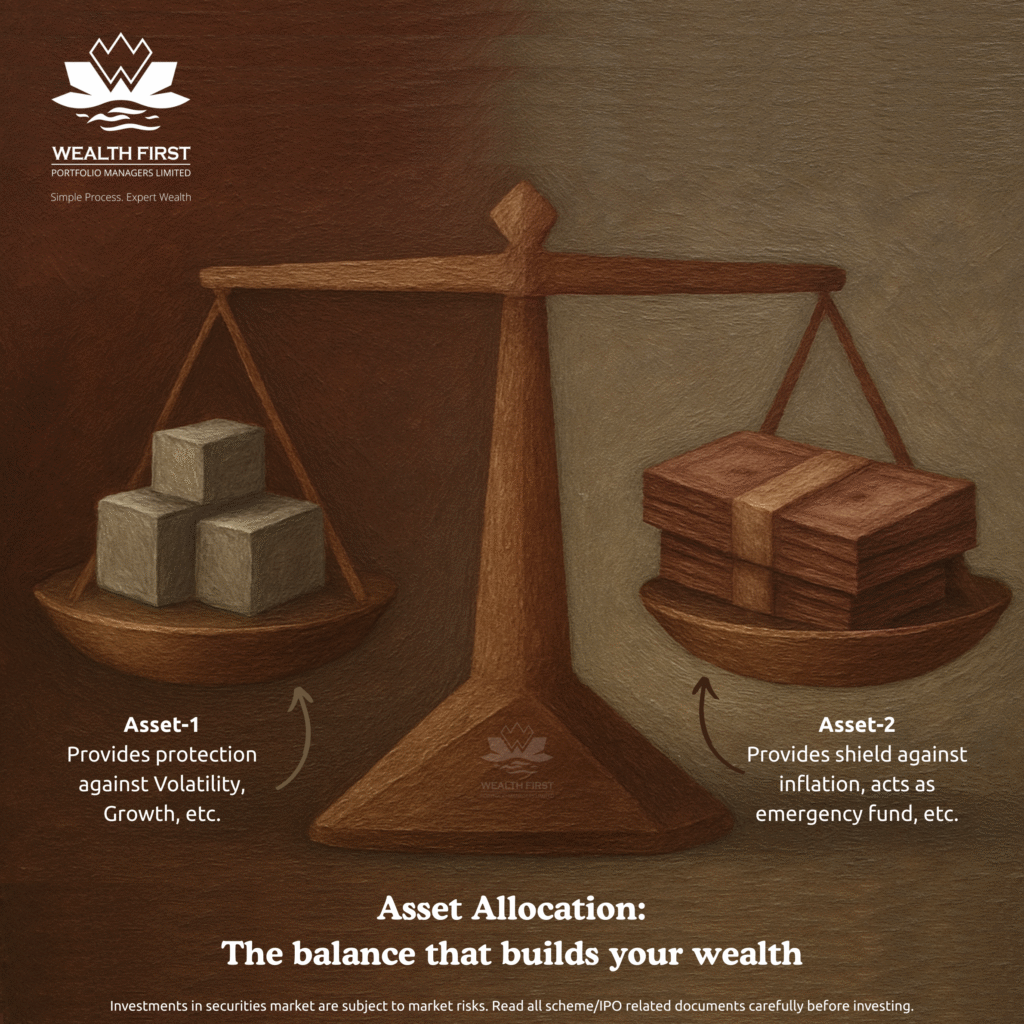
Wealth First Explains how the right mix of assets helps you build wealth with stability
When it comes to building wealth, investing isn’t only about what you buy, but also about how much of each type of asset you own. That balance between equities, debt, gold, real estate, and cash is called asset allocation, and it forms the backbone of every successful financial plan.
What is Asset Allocation?
Asset allocation means dividing your investments across different asset classes such as equity, debt, gold, and cash based on your goals, age, and risk appetite. By diversifying across assets, you reduce risk, smoothen returns, and ensure that one poor-performing investment doesn’t derail your entire portfolio.
_________________________________________________________________________________
_________________________________________________________________________________

Why Asset Allocation Matters in Personal Finance
Asset allocation helps you:
- Manage risk: Different assets react differently to market movements. When equities fall, debt or gold may hold steady.
- Achieve consistency: Balanced portfolios grow more steadily over time.
- Align with goals: Each goal—short-term or long-term—can have its own allocation mix.
- Stay disciplined: It helps avoid emotionally driven investment decisions driven by market noise.
In essence, asset allocation is what turns investing into financial planning.
Asset Allocation and Age
Your age plays a crucial role in determining how much risk you can take. Generally, younger investors can afford to hold more equities because they have time to ride out volatility. As you grow older, the focus should gradually shift toward capital preservation.
A simple thumb rule:
Equity Allocation (%) ≈ 100 – Age
However, this is only a guideline. Your actual mix should reflect your personal circumstances, goals, and risk tolerance. There are countless instances of this rule not being applicable due to any of these parameters.
Same Age, Different Goals = Different Allocation
Consider two 35-year-olds:
- Investor A: Wants to buy a house in 5 years.
- Needs stability → higher debt allocation (say 60% debt, 40% equity).
- Investor B: Saving for retirement 25 years away.
- Can take higher risk → higher equity allocation (say 80% equity, 20% debt).
Even though both are the same age, their goals change the right mix. This is why goal-based asset allocation is far more effective than following one-size-fits-all formulas.
Example: Balanced Allocation vs Haphazard Investing
Let’s compare two investors who each have ₹10 lakh to invest:
- Investor X (Balanced Approach)
- 60% Equity, 30% Debt, 10% Gold
- Gains steady returns with moderate volatility.
- Investor Y (Haphazard Approach)
- Invests randomly—some stocks, some FDs, no clear plan.
- Experiences wild swings and underperformance due to lack of balance.
Over 10 years, even if both achieve similar average returns, Investor X will likely end up with higher wealth consistency and fewer emotional decisions, because asset allocation acts as an invisible stabilizer.
📞 Talk to Our Wealth Managers
Your ideal allocation depends on more than age—it depends on your life goals, financial situation, and comfort with risk.
👉 Talk to Us to get a personalised asset allocation plan from Wealth First’s experts.
We’ll help you find the right balance between growth and safety tailored to your needs.
How to Balance Risk and Reward
- Don’t chase only high returns—look for risk-adjusted returns.
- Review your portfolio annually and rebalance if allocations drift.
- Use professional guidance to align your mix with your goals and time horizon.
Key Takeaways
- Asset allocation is the foundation of smart investing.
- Your mix should reflect both your age and goals.
- Consistent rebalancing keeps your portfolio healthy.
- Diversification helps you manage volatility without sacrificing growth.
Soft CTA
At Wealth First, we help investors create custom asset allocation strategies that evolve with their life stages and goals.
👉 Use our Wealth Calculator to explore projections, or Talk to Us to get a personalised plan.
📌 Disclaimer
The content shared by Wealth First is for general informational and educational purposes only and should not be considered as investment advice, research, or a solicitation to buy or sell any financial product. All information in emails, posts, and articles from Wealth First is intended solely to increase financial awareness. Past performance is not indicative of future results. All investments are subject to market risks, including possible loss of principal. Readers should consult their financial, legal, or tax advisors before making any investment decisions tailored to their personal circumstances. While utmost care is taken to ensure accuracy of information, Wealth First does not guarantee completeness, reliability, or timeliness, and shall not be liable for any direct or indirect loss arising from reliance on such information. By subscribing to or engaging with our content, you acknowledge that you are doing so at your own discretion, and that Wealth First is not responsible for individual investment outcomes.
